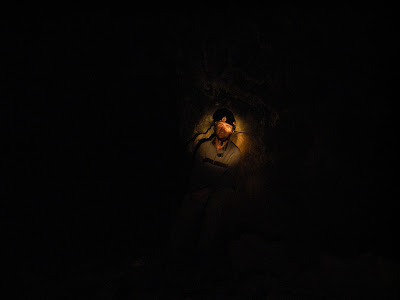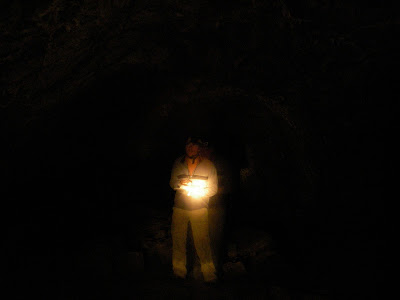"The Longest Lava Tube in California"
 |
| Deep in the back of "The Catacombs" |
Deep in the heart of Lava Beds National Monument lies "The Catacombs" which by far the longest cave in the park and one of the longest lava tubes in the country. It is 6,903ft ONE WAY so its 2.5 mile (4km) long caving adventure. For those of you looking for an ultimate challenge, this is the true test of one's grit.
The map of this cave is copy written. This post provides information on the challenges you will encounter if you cave the Catacombs. This is not a strict guide; buy a map at Lava Beds National Monument
Caving is a dangerous sport. Get the training and experience you need before attempting this cave.
The Challenges of Caving the Catacombs
"The Catacombs" is a lava tube which needs no technical climbing gear but requires the utmost ability in navigation. This cave is a difficult cave for many reasons. First of all, it is a
literal 3D maze. There are a large number of side chambers and passages which may or may not lead in the direction you would like to travel. This is why it is
highly recommended that you study the cave map before exploring. I noticed that when I was caving this tube, I would literally stop every 20ft and re-assessed my location. Caving is a sport that teaches you to truly depend on a compass as a lifeline, so if you aren't comfortable with you skills, this isn't a beginner's cave.
 |
| An section with 8 inches of clearance (20cm) |
The second thing to consider is the
extremely tight clearance of the cave. This cave has sections that have only 8 inches (20cm) of ceiling height. There is a particularly difficult section has about 12 inches (30cm) of clearance for a full 100ft (33m). I remember this part taking an extreme amount of self control; if you don't mentally prepare for this challenge, you could find yourself losing it in a very difficult section.
Also, wear a helmet and knee-pads!
 |
| Get your bearings at the entrance! |
Lastly, before going on this adventure, consider the time you will be down in this cave. It took me a full 3 hours of painstakingly slow movement to get to the back and out of the cave. The rangers of the park may quote you even longer times than that. Caving takes patience and the ability to constantly monitor yourself for signs of fatigue. It is easy to get lost if you're not constantly checking your position on the map and making sure you still have the energy to get out! I was sweating profusely as I moved through this cave, even in the winter.
 |
| About 30ft from the back of the cave |
One final note, bring a backpack that can fit through tight spaces. I attempted to bring a full sized day pack through a similar cave and it was too challenging to bring even a midsized pack. Take what you need, but bring a small pack.
 |
| Surviving "The Catacombs"! |
So Why Do It?
Caving is unlike anything I had ever encountered before. It requires a different degree of self-reliance and control. What I remembered fondly of my experience in The Catacombs was learning how to really trust yourself to a compass. Surface navigation is done more easily and it easily makes a person complacent. Learning how to depend on a compass and map is a critical skill for a true outdoorsman; caving helps facilitate this trust.
Another thing I appreciated about caving was how easily one can adapt to a different reality. On the surface (literally), we tend to rely fully on our eyesight. Caving is a completely different sport. I found myself forced to rely on touch, prediction, memory and most importantly, good judgement rather than simply what I could directly see. Again, these are all skills that greatly help the adventurer in becoming more well rounded and inevitably safer. In the short time that I spent in Lava Beds National Monument, I learned much about myself and how to become a better navigator.
So, if you intend on venturing into The Catacombs, keep your eyes on your compass and don't be afraid to turn around if it gets too difficult.
Read. Plan. Get Out There!











6 Comments
Josh McNair
September 28, 2012 @ 16:39
Wow this is a crazy post. I don't think I could do this I am too claustrphobic but I appreciate the write up. 12 inch clearance for 100 feet, thats nuts.
Roger
October 16, 2020 @ 21:07
My first trip to the Lava Tubes in 1997 I got In half way ,got lost and only found my way out by my compass. I returned on 10/12/20 and made it all the way in with lots of side tube exploration and out. Do not even try it without the MAP- compass, hard face knee pads , helmet, headlamp and gloves . It’s best to have your hands free. So a very small pack and extra flash light. We were in the tube for 4 hours. And it was a full body workout. Have Fun!
Quincy Koetz
October 19, 2020 @ 14:21
What a maze that place is! A natural labyrinth
Yevonda
November 22, 2020 @ 16:25
Coming to Lava Beds was our first caving experience! We did about 4 caves and thought let’s check out the beginning of Catacombs. We needed up going back a ways past Boxing Glove Chamber and ended up getting lost. We made a circle back around to Boxing Glove because we were trying to exit via memory. After coming full circle we sat down on the stairs, got our bearings and used the map inside of the Lava Beds Cave book that you can buy at the visitor center to get out. We are already planning on coming back in a few months to spend a lot of time in the cave and becoming more and more familiar with it to the point we feel comfortable making it to the end!! I read somewhere there is a book at the end that you write your name and date in. Is this true?? Thanks for the blog guys!!
Quincy Koetz
November 23, 2020 @ 02:14
That’s interesting! I didn’t come across a book at the end when I did it but that was almost a decade ago at this point. That would be one heck of a geocache if there was!
Brian
July 10, 2023 @ 18:54
Do NOT write on cave walls!